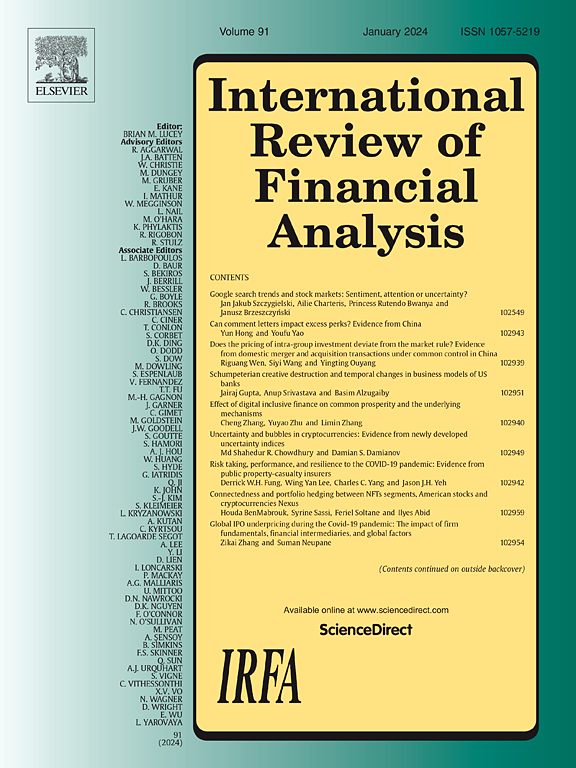G-SIB资本监管抑制棕色贷款的效率有限
IF 7.5
1区 经济学
Q1 BUSINESS, FINANCE
引用次数: 0
摘要
当增加资本充足率的缓冲时,银行的自然反应似乎是贷款的收缩,反之亦然,即缓冲的减少应该导致更多的贷款。我们希望绿色贷款和棕色贷款的效果相同。然而,我们只拥有棕色贷款的细粒度数据。尽管如此,我们仍然能够发现关于棕色贷款与全球银行资本监管相互作用的新发现。不考虑2019年以来全球银行棕色贷款收缩的总体趋势,我们发现,全球银行更倾向于对资本监管的放松做出反应,而不是对资本监管的收紧做出反应。这意味着在其他条件相同的情况下,G-SIB资本缓冲的增加不会导致棕色贷款的收缩,而它的减少会在更多的棕色贷款中得到反应。根据我们的估计,自监管引入以来,G-SIB资本缓冲减少导致额外的棕色贷款总额相当于截至2022年底棕色贷款总额的20%。虽然绿色贷款可以刺激同样的速度,但我们所能从数量上证明的是对棕色贷款的确切影响。这意味着,在央行政策的一个领域(即银行业监管)内的决策,可能同时在环境领域产生意想不到的后果。换句话说,当监管机构认为一家全球性银行的系统重要性已经下降,应该获得较小的G-SIB资本缓冲时,监管机构就会通过这种行动恶化实现气候友好型目标的道路。相反,要求全球银行更加谨慎会让它们变得更加环保。在这种情况下,唯一的副作用是影子棕色银行的潜在扩散。本文章由计算机程序翻译,如有差异,请以英文原文为准。
Limited efficiency of G-SIB capital regulation in curbing brown lending
The natural reaction of banks when increasing the buffer for the capital adequacy ratio seems to be the contraction of lending, as well as vice versa, i.e., buffer reduction should result in more lending. We wish the effects to be equivalent for the green and brown lending. However, we possess granular data for brown lending only. Still, we are able to discover novel findings with respect to brown lending interplay with the capital regulation of global banks. Disregarding the overall trends for the brown lending contraction within the set of global banks since 2019, we reveal that the global banks are more prone to react to capital regulation easing, rather than to its tightening. This means that G-SIB capital buffer rise does not contribute to the brown lending contraction all else being equal, while its reduction finds response in more brown lending. According to our estimate, G-SIB capital buffer reduction since the regulation introduction resulted in extra brown loans in total equal up to 20% of the brown loan book as of end-2022. Though green loans could have spurred to the same pace, all we can to quantitatively prove is the definite impact for the brown lending. It implies that decision-making within one area of Central Bank policies - namely, banking regulation - can have an unintended consequence within the environmental domain same time. In other words, when the regulator thinks that a global bank has become less systemically important and deserves a smaller G-SIB capital buffer, by such an action the regulator deteriorates the path towards meeting the climate-friendly objectives. On the opposite, requiring global banks to be more prudent results in them being greener. The only side-effect in such a case is the potential proliferation of shadow brown banking in parallel.
求助全文
通过发布文献求助,成功后即可免费获取论文全文。
去求助
来源期刊

International Review of Financial Analysis
BUSINESS, FINANCE-
CiteScore
10.30
自引率
9.80%
发文量
366
期刊介绍:
The International Review of Financial Analysis (IRFA) is an impartial refereed journal designed to serve as a platform for high-quality financial research. It welcomes a diverse range of financial research topics and maintains an unbiased selection process. While not limited to U.S.-centric subjects, IRFA, as its title suggests, is open to valuable research contributions from around the world.
 求助内容:
求助内容: 应助结果提醒方式:
应助结果提醒方式:


